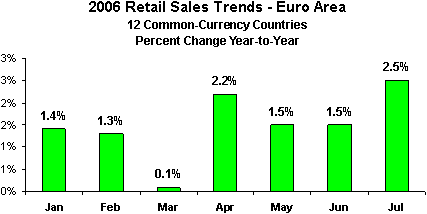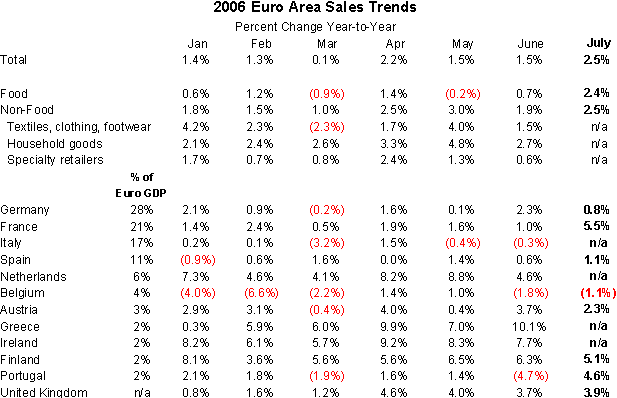IDEX Online Research: Euro-Zone High Street Sales Strengthen in July
September 14, 06
Retail sales in the Euro-Zone continued to show strength in July. On a year-to-year comparison, retail sales in the Euro-Zone (12 countries with a common currency) were up 2.5 percent from July 2005. By far, this was the strongest gain so far in 2006, as the graph below illustrates.
Source: Euro Stat

Retail sales in all 25 European Union countries were stronger – posting a gain of 3.3 percent in July, one of the strongest increases this year.
Retail Sales Strong Across All Categories
Euro-Zone retail sales are subdivided by two major categories – Food and Non-Food. Retail sales of “food” rose by 2.4 percent in July, while “non-food” retail sales were up by 2.5 percent. In prior months, the disparity between these categories has been much greater. Euro-Zone retail sales are summarized by broad categories. Thus, jewelry sales trends are not available. However, jewelry demand tends to reflect broader market trends. This would indicate that jewelry sales were relatively strong in July among Euro-Zone retail merchants.
Consumer Demand Solid Across the Euro-Zone
On a country-by-country basis, July retail sales showed generally solid gains. France was the star, in terms of large economies, with a retail sales gain of 5.5 percent for the month. Germany, the largest economy in the Euro-Zone, posted a much more muted 0.8 percent gain in retail sales.
Other countries reporting solid gains included Spain, Portugal, Austria, Finland, and the United Kingdom. Unfortunately, Belgium reported a modest decline in retail demand in July.
The table below summarizes retail sales for major countries in the Euro Area.
Source: Euro Stat

Factors Affecting Consumer Demand
Unemployment rates have been falling throughout the Euro-Zone, and have declined steadily since the end of 2005. Consumer confidence is solid, though this is not a good predictor of retail demand.
Economic strength continued to gain momentum in the second quarter, providing a boost to July retail sales. Strong domestic demand is behind much of this economic momentum.
Euro-Zone Economic Outlook: Solid Second Half
There are two key factors pulling at the Euro-Zone economy in opposite directions. Employment is pulling the economy toward growth, while trade is hampering growth.
The labor markets are showing solid growth across the region, with only a very few countries experiencing increased joblessness. Of those, the only large economy facing a weakening job market is the U.K., and its employment rate is still well below the historical average. Across the European Union (25 countries), the employment rate has been rising steadily and job creation has picked up after hitting a bottom in 2003. This is partly the reflection of catch-up development, but is also due to improvement in the core markets: the unemployment rate in the Euro-Zone fell for a four and a half-year low of 7.8 percent in June, while in the first quarter employment growth accelerated for the third straight quarter.
Analysts’ surveys suggest this economic improvement will continue, as the business sector takes advantage of the improvement in corporate balance sheets due to restructured debt and the past few years of record low interest rates. Both the Manpower Employment Outlook survey and the Monster online job index were reasonably optimistic heading into the third quarter, with few exceptions. Manpower noted robust hiring intentions in the U.K., Norway, and Ireland, but some softness in Germany and Italy. The Monster index, meanwhile, notched its second consecutive large gain in July, led by hiring in Germany and France.
The PMI employment survey for Europe suggests sustained, if sometimes volatile, employment growth, both for services and manufacturing. While the pace of job creation is certainly not on par with Asia or, until recently, the U.S., it is better than many continental European economies have seen in years. More widespread hiring means increased disposable income, which in turn helps offset the impact of higher transport and housing costs, and should hopefully translate to more rapid consumption growth.
On the downside, the precipitous and persistent increase in the energy trade deficit of most European economies will continue to be a drag on aggregate expansion. The doggedness of high energy prices only benefits two European nations – Russia and Norway – since the U.K.’s days as an oil exporter are nearly over, and the country’s dependence on imported gas is helping push the current account deficit toward a record high.
Continuing supply concerns and fear of new geopolitical challenges imply that $60+ oil is something that energy-importing nations will just have to accept. Wide trade deficits will continue to draw capital out of many European nations and inflate their current account deficits.
The only good news is that the positive and negative risks for the Euro-Zone are broadly in balance. The momentum of the first half will carry through into the second half, which should also benefit the early months of 2007. This bodes well for retail sales in the all-important holiday selling period of November and December.
Longer term, with next year’s outlook for the U.S. and Germany dimming, and higher interest rates spreading across the Euro-Zone to rein in the expansion, we expect a less aggressive expansion in 2007. Consensus forecasts call for European Union economic growth of about 2.1 percent-2.2 percent in 2006 and slowing to 1.8 percent-1.9 percent in 2007.
Statistical Note
Preliminary country-by-country retail sales figures are subject to significant revision. IDEX Online Research tables in this report reflect the latest revisions.